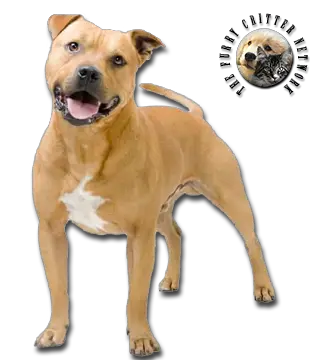Breed Standard
Head: Short, deep through. Broad skull. Distinct stop. Short nose bridge. Very pronounced cheek muscles. Strong jaws. Tight lips.
Ears: Rose or half-prick.
Eyes: Medium size, round. Dark color. Dark rims.
Body: Compact and powerful. Muscular, moderately short neck. Broad forechest. Chest is well let down. Ribs well sprung. Horizontal topline.
Tail: Medium length, set low, and tapering toward the tip. Carried moderately low.
Hair: Short, smooth, dense.
Coat: Red, fawn, white, black, or blue, or any of these colors with white. Any shade of brindle with or without white.
Size: 35 to 40 cm ( 14 to 15.5 in).
Weight: Dog: 12.7 to 17.2 kg (28-38 lb).Bitch: 10.8 to 15.4 kg (24-34 lb).
History
The progeny of the hybrid crosses between bulldogs and terriers were sometimes referred to as half-and-halfs and half-breds but became more commonly known as the bull and terrier. Of the six distinct breeds that descended from the bull and terrier breeds, five are recognised by the American Kennel Club (AKC) in the following order: Bull Terrier, Boston Terrier, American Staffordshire Terrier (AmStaff), Staffordshire Bull Terrier, and Miniature Bull Terrier. The same five breeds are also recognised by the Canadian Kennel Club (CKC), and Fédération cynologique internationale (FCI). The American Pit Bull Terrier (APBT) is recognised by the United Kennel Club (UKC). The English Kennel Club recognizes only four of the breeds and does not accept the AmStaff or APBT. The United Kennel Club describes the Bull Terrier as "the direct descendant of the original bull-and-terrier cross made in England, specifically to bait bulls and, later to fight in pits". Their description of the Staffordshire Bull Terrier states that the breed shares "the same ancestry as the Bull Terrier, i.e. Bulldog crossed with the Black and Tan terrier, and was developed as a fighting dog."
In the mid–19th century, the bull and terrier hybrids were known by several different aliases, such as the Patched Fighting Terrier, Staffordshire Pit-dog, Brindle Bull, and Bull-and-Terrier. A common name was simply the Bull Terrier, which was later associated with the Hinks' Bull Terrier; a socially acceptable "gentleman's companion" with refinement, cleaner lines, and courage without aggressive tendencies. During the development of Hinks' new breed of Bull Terrier, also known as the White Cavalier, various undocumented outcrosses were used that the devotees of the original strains of bull and terrier crosses didn't like, such as the Dalmatian and Collie, and they chose instead to remain loyal to their preferred type. As a result, two different breeds of Bull Terriers emerged: the Bull Terrier and Staffordshire Bull Terrier. The Bull Terrier's fighting heritage was left behind whereas breeders of Staffordshire Bull Terriers in the UK continued their illegal competitions which paralleled what was happening in the U.S. with the American Staffordshire Terrier; neither breed could gain official acceptance in their respective native lands. "No established registry wanted to be affiliated with a dog that drew the blood of its own kind for a living."
By 1874, in Britain the first Kennel Club Stud Book was published, which included Bull Terriers and Bulldogs. In 1935, The Kennel Club accepted Staffordshire Bull Terriers into their studbook with established breed standards. It wasn't until 1974 that the AKC admitted Staffordshire Bull Terriers as a purebred as their 121st registered breed.
Behavior
This vigorous, courageous, highly tenacious , bold, strong-willed dog is, in fact, calm and stable. If trained properly, he is gentle and affectionate with his owners, though is a formidable, aggressive guard dog as required. The breed’s reputation with children is second to none. Adored and adoring within its family circle. It is usually good with other pets in the household if raised together. When well cared for and properly trained they can make brilliant companions.
The Staffordshire Bull Terrier can adapt to life as a house dog if he gets plenty of exercise. Regular brushing is required.
Function
Guard Dog, Pet
Health
Staffordshire Bull Terriers are known to suffer from Hereditary Cataracts and L-2-hydroxyglutaric aciduria a metabolic disorder resulting in behavioral changes and dementia-like symptoms, both of which are detectable via DNA tests. Distichiasis (commonly known as “double eyelash”) and Persistent Hyperplastic Primary Vitreous, a condition whereby the blood supply to the ocular lens fails to regress and fibrovascular tissue forms causing hazy vision, both of which are checked by way of an ocular examination throughout the life of a breeding stud or brood-bitch to minimize the transfer and spread of these conditions. The breed is known to be at a higher risk from mastocytoma (mast cell tumours) than the general population of dogs.






